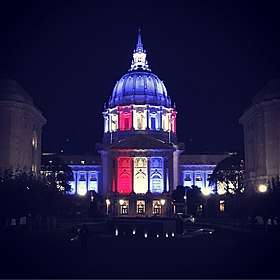Election Day (United States)
In the United States, Election Day is the annual day set by law for the general elections of federal public officials. It is statutorily set as "the Tuesday next after the first Monday in the month of November" or "the first Tuesday after November 1".[1] The earliest possible date is November 2, and the latest possible date is November 8.

| National Election Day | |
|---|---|
| Type | Day for the election of public officials in the United States |
| Celebrations | Exercising civic duty, voting for elected officials, visiting polling precincts |
| Date | The Tuesday after the first Monday of November |
| 2019 date | November 5 (Details) |
| 2020 date | November 3 (Details) |
| 2021 date | November 2 (Details) |
| 2022 date | November 8 (Details) |
| Frequency | annual |
For federal offices (President, Vice President, and United States Congress), Election Day occurs only in even-numbered years. Presidential elections are held every four years, in years divisible by four, in which electors for President and Vice President are chosen according to the method determined by each state. Elections to the US House of Representatives and the US Senate are held every two years; all Representatives are elected to serve two-year terms and are up for election every two years, while Senators serve six-year terms, staggered so that one third of Senators are elected in any given general election. General elections in which presidential candidates are not on the ballot are referred to as midterm elections. Terms for those elected begin in January the following year; the President and Vice President are inaugurated (sworn in) on Inauguration Day, which is usually on January 20.
Many state and local government offices are also elected on Election Day as a matter of convenience and cost saving, although a handful of states hold elections for state offices (such as governor) during odd-numbered off years, or during other even-numbered midterm years, and may hold special elections for offices that have become vacant. Congress has mandated a uniform date for presidential (3 U.S.C. § 1) and congressional (2 U.S.C. § 1 and 2 U.S.C. § 7) elections, though early voting is nonetheless authorized in many states.
Election Day is a public holiday in some states, including Delaware, Hawaii, Kentucky, Louisiana, Montana, New Jersey, New York, Virginia, West Virginia, and the territory of Puerto Rico. Some other states require that workers be permitted to take time off with pay. California Elections Code section 14000 provides that employees otherwise unable to vote must be allowed two hours off with pay, at the beginning or end of a shift. A federal holiday, Democracy Day, to coincide with Election Day has been proposed. Other movements in the IT and automotive industries encourage employers to voluntarily give their employees paid time off on Election Day.
History
By 1792, federal law permitted each state to choose Presidential electors any time within a 34-day period[2] before the first Wednesday in December.[3] A November election was convenient because the harvest would have been completed but the most severe winter weather, impeding transportation, would not yet have arrived, while the new election results also would roughly conform to a new year. Originally, states varied considerably in the method of choosing electors. Gradually, states converged on selection by some form of popular vote.
Development of the Morse electric telegraph, funded by Congress in 1843 and successfully tested in 1844, was a technological change that clearly augured an imminent future of instant communication nationwide.[4] To prevent information from one state from influencing Presidential electoral outcomes in another, Congress responded in 1845 by mandating a uniform national date for choosing Presidential electors.[1] Congress chose the first Tuesday after the first Monday in November to harmonize current electoral practice with the existing 34-day window in federal law, as the span between Election Day and the first Wednesday in December is always 29 days.[5] The effect is to constrain Election Day to the week between November 2 and November 8 inclusive. Beginning with Presidential elections, gradually all states brought nearly all elections into conformity with this date.
Criticism
Most voters have to work on Tuesdays. This has led activists to promote alternatives to improve voter turnout. Alternatives include making Election Day a federal holiday or merging it with Veterans Day,[6][7] allowing voting over multiple days, mandating paid time off to vote, encouraging voters to vote early or vote by mail, and encouraging states to promote flexible voting.
Holiday and paid leave

Delaware, Hawaii, Illinois, Kentucky, Montana, New Jersey, New York, Ohio, Virginia, West Virginia, and the territory of Puerto Rico have declared Election Day a civic holiday. Some other states require that workers be permitted to take time off from employment without loss of pay. California Elections Code Section 14000 and New York State Election Law[8] provide that employees without sufficient time to vote must be allowed two hours off with pay, at the beginning or end of a shift. Democracy Day, a planned federal holiday to coincide with Election Day, was unsuccessfully proposed in the U.S. House of Representatives and the U.S. Senate in 2005. It was later reintroduced in the Senate in 2014 and has not been enacted.
Some employers allow their employees to come in late or leave early on Election Day to allow them an opportunity to get to their precinct and vote. The United Auto Workers union has negotiated making Election Day a holiday for workers of U.S. domestic auto manufacturers. In July 2016, venture capitalist Hunter Walk began encouraging tech companies to give their employees time off to vote on Election Day.[9] Walk's campaign evolved into a website, TakeOffElectionDay.com, which now highlights the 140+ tech companies (including Spotify, Wikimedia Foundation, Autodesk, and Square, Inc.)[10] that are giving their employees time to vote on Election Day. In January 2019, Sandusky, Ohio became the first city in the country to make Election Day a paid holiday for city employees by eliminating Columbus Day.[11]
On April 12, 2020, Virginia governor Ralph Northam signed legislation that established Election Day as a holiday.[12]
On June 16, 2020, Illinois governor J.B. Pritzker signed legislation that established Election Day as a holiday.[13]
Democratic Representative John Conyers of Michigan proposed H.R. 63 – Democracy Day Act of 2005[14] for the Tuesday after the first Monday in November of every even-numbered year, to be a legal public holiday called Democracy Day. The purpose of the holiday was to increase voter turnout by giving citizens more time to vote, as well as to allow for the opening of more polling places with more workers while raising awareness of the importance of voting and civic participation. The bill was reintroduced on Nov. 12, 2014 and again on Sep 25, 2018 by independent Senator Bernie Sanders. It has never been enacted.[15][16]
Early and postal voting
Most states allow for early voting, allowing voters to cast ballots before the Election Day. Early voting periods vary from 4 to 50 days prior to Election Day. Unconditional early voting in person is allowed in 32 states and in D.C.[17] Also, most states have some kind of absentee ballot system. Unconditional absentee voting by mail is allowed in 27 states and D.C., and with an excuse in another 21 states.[17] Unconditional permanent absentee voting is allowed in 7 states and in D.C.[17]
In Colorado, Oregon, Washington, Utah, and Hawaii all major elections are by postal voting, with ballot papers sent to voters several weeks before Election Day.[18] In Colorado and Oregon, all postal votes must be received by a set time on Election Day, as is common with absentee ballots in most states (except overseas military ballots, which receive more time by federal law). Washington requires postal votes be postmarked by Election Day. For the 2008 presidential election, 32% of votes were early votes.[19]
See also
- Democracy Day (United States)
- Election
- Primary election
- Public holidays of the United States
- Special election
- U.S. state holiday
References
- Statutes at Large, 28th Congress, 2nd Session, p. 721.
- Annals of Congress, House of Representatives, 2nd Congress, 1st Session, p. 278.
- Statutes at Large, 2nd Congress, 1st Session, p. 239.
- William C. Kimberling, The Electoral College, Federal Election Commission, 1992, pp. 6-7
- Congressional Globe, House of Representatives, 28th Congress, 2nd Session, pp. 14-15.
- Sutter, John D. (12 November 2012). "Election Day should be a federal holiday". CNN. Retrieved 20 October 2016.
- "Policy Proposals". Retrieved 20 October 2016.
- "New York State Election Law, § 3-110" (PDF). Retrieved 2016-10-07.
- "Why You Should Give Your Employees Election Day Off". 2016-08-04. Retrieved 2016-08-05.
- "News and Press Releases | Square". squareup.com. Retrieved 2016-08-05.
- "Sandusky's gov't eliminates Columbus Day as holiday", Sandusky Register, Jan 30, 2019, retrieved Sep 26, 2019
- LeBlanc, Paul (April 12, 2020). [April 12, 2020 "Illinois governor expands vote by mail, makes election day a state holiday"] Check
|url=value (help). - Roberts, Jim (June 19, 2020). "Virginia governor makes Election Day a holiday and expands early voting". CNN. Retrieved June 19, 2020.
- "H.R.63 - Democracy Day Act of 2005". Congress.gov. Retrieved 11 November 2019.
- Civic Impulse. (2015). S. 2918 — 113th Congress: Democracy Day Act of 2014. Retrieved from https://www.govtrack.us/congress/bills/113/s2918
- "S. 3498 (115th): Democracy Day Act of 2018". GovTrack. Civic Impulse. Retrieved 7 July 2019.
- "Absentee and Early Voting". National Conference of State Legislatures. Retrieved 2012-10-30.
- Absentee and Early Voting. National Conference of State Legislatures.
- Michael McDonald (2010-05-01). "(Nearly) Final 2008 Early Voting Statistics". Department of Public and International Affairs, George Mason University. Archived from the original on 2012-07-30. Retrieved 2012-10-30.
External links
- "Voting On Tuesday: How is This Still a Thing?", Last Week Tonight with John Oliver, HBO, November 5, 2016 – via YouTube